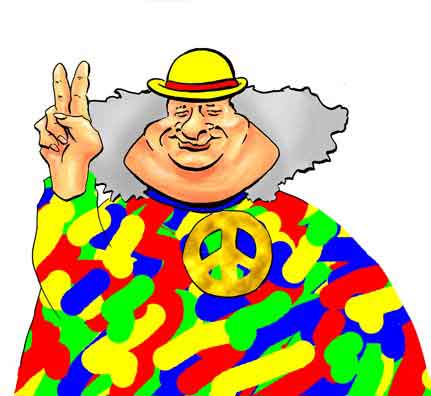Hugh Romney - Wavy Gravy

If you've seen the movie Woodstock, you've seen Hugh Romney when he got up on the stage and announced that there will be breakfast in bed for 400,000. Everyone there must be in heaven, he said and added that there was a little bit of heaven in any disaster area.
Although Governor Nelson Rockefeller did indeed declare Woodstock a state disaster area - actually it was the area around Bethel - this was probably more of a political statement than a necessity. Remember this was the day when (gasp!)  were seen as a threat to the security of the country and the American way of life rather than providing models for costumes of middle class kids on Halloween.
were seen as a threat to the security of the country and the American way of life rather than providing models for costumes of middle class kids on Halloween.
Originally there was little thought that there would be problems with providing for the multitude. But it turned out that companies that specialized in food concessions were spooked by the logistics of the event - the expected turnout was to be 200,000 - and even Nathan's Hot Dogs was scared off. The day before the festival there were no food stands on site - and 400,000 people were knocking at the gates. This snafu led to recriminations - and even some fisticuffs according to one story - amongst the organizers.
Fortunately, a number of people had brought their own refreshments, and finally the residents of the county and local groups (including the Women's Group of the Jewish Community Center and Max Yasgur who owned the land) managed to get together impressive quantities of food for the kids. Even more impressive is they actually got it to the concert. True, the food was nothing fancy, just a concoction of various cereals and grains now ubiquitously associated with the 1960's counterculture and which we now call granola.
Granola, though, actually has a long and venerable history. The name itself goes back to the 19th century where physician and food entrepreneur, John Harvey Kellogg, tacked the name to one of his products which he had developed when he was the supervisor of the Battle Creek (Michigan) Sanitarium. It's not exactly clear what the staff at the Sanitarium treated, but we will say that internal medicine as taught in the 19th century was a hodgepodge of practices which evolved to treat a set of illnesses that were so ill-defined that their reality is often suspect. Also this was the day of the "health-cure" popular with the well-to-do and increasing middle class who used their illnesses to more or less justify taking a vacation.
But whatever ailed the patients, Dr. Kellogg had the cure. Among the cure was exercise, rest, and eating right. Unfortunately a number of the patients were elderly and had bad (or no) teeth, making a good diet problematic because a common hospital food of the time was zwieback - a hard twice-baked bread that was difficult and painful when hammered with toothless gums. So Dr. Kellogg took the zwieback and other hard breads - such as the new-fangled Graham Crackers - and ground them up. The "granules" were served in milk and Dr. Kellogg called his new cereal "Granola".
Granola fell out of favor in the early to mid-twentieth century as Americans went for more protein, less vegetables, and more fat. But its appearance at Woodstock gave the food a boost within the counterculture, and it, now often with nuts and dried fruits, became a staple of the health-conscious although some nutritionists have criticized the modern versions - particularly the bars - which are sometimes fortified with sugar to suit the modern American palate and expanding paunch.
Like many specialists foods, commercial granola can be on the pricey side. But it can also be made economically at home, the recipes reading a lot like the cereal substitutes found in England during the Second World War.
Dr. Kellogg not only believed in a healthy diet, but was also a crusader against bad habits which he felt his vegetarian diet would discourage. One of these - ah - "habits" that he found distressingly common we won't name lest we bring a blush to the cheeks of young children, dainty women and delicate men. But regarding this activity Dr. Kellogg stated, "Those who commit it place themselves far below the meanest brute that breathes. The most loathsome reptile, rolling in the slush and slime of its stagnant pool, would not bemean itself thus. It is true that monkeys sometimes have the habit, but only when they have been taught it by vile men or boys. A boy who is thus guilty ought to be ashamed to look into the eyes of an honest dog."
References
"Woodstock - How to Feed 400,000 Hungry Hippies", Lisa Bramen, Smithsonian, August 14, 2009.
"The Big Woodstock Rock Trip", Life Magazine, August 29, 1969.
Food and Drink in American History: A "Full Course" Encyclopedia, 3 Volumes, Andrew Smith, ABC-CLIO, 2013
Plain Facts for Old and Young: Embracing the Natural History and Hygiene of Organic Life , J. H. Kellogg, M. D., Segner, 1890.